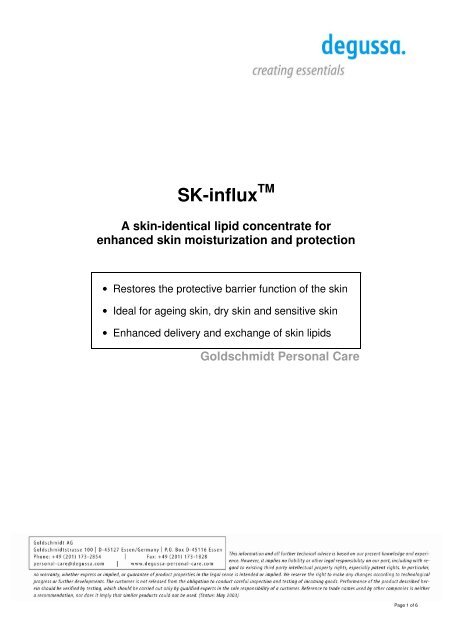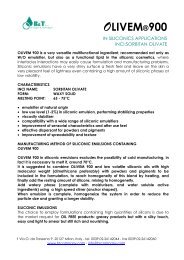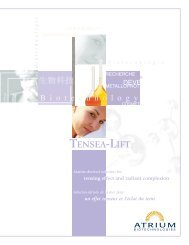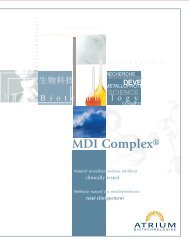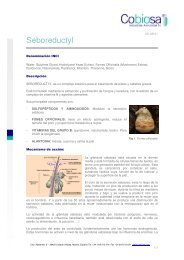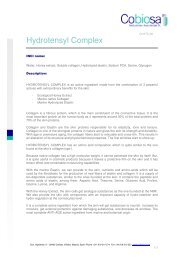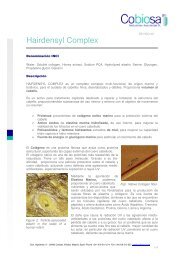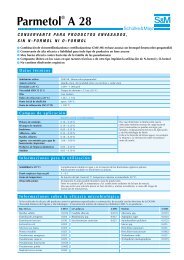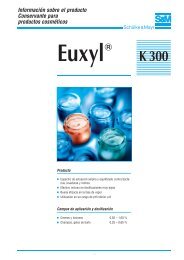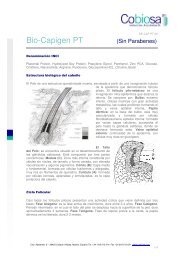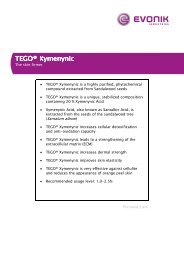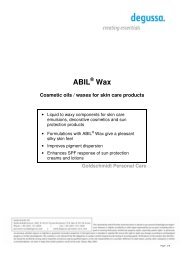SK-influx - Quetzal Quimica
SK-influx - Quetzal Quimica
SK-influx - Quetzal Quimica
You also want an ePaper? Increase the reach of your titles
YUMPU automatically turns print PDFs into web optimized ePapers that Google loves.
<strong>SK</strong>-<strong>influx</strong> TM<br />
A skin-identical lipid concentrate for<br />
enhanced skin moisturization and protection<br />
• Restores the protective barrier function of the skin<br />
• Ideal for ageing skin, dry skin and sensitive skin<br />
• Enhanced delivery and exchange of skin lipids<br />
Goldschmidt Personal Care<br />
Page 1 of 6
INCI Name (CTFA name)<br />
Ceramide 3; Ceramide 6 II; Ceramide 1;<br />
Phytosphingosine; Cholesterol; Sodium Lauroyl<br />
Lactylate; Carbomer; Xanthan Gum<br />
Chemical and physical properties<br />
(not part of specifications)<br />
Form<br />
viscous liquid<br />
Active matter 2.5 %<br />
Properties<br />
• <strong>SK</strong>-<strong>influx</strong> TM is a skin-identical lipid<br />
concentrate, which restores the protective<br />
barrier function of the skin.<br />
• <strong>SK</strong>-<strong>influx</strong> TM is a concentrated formulation,<br />
consisting of a multi-lamellar (membrane)<br />
system resembling the structure of the lipid<br />
barrier in the Stratum Corneum.<br />
• A concentrated mix of different types of<br />
ceramides, cholesterol, free fatty acids and<br />
phytosphingosine makes it an ideal<br />
ingredient for personal care products with<br />
unique restoring capabilities.<br />
• Application of <strong>SK</strong>-<strong>influx</strong> TM will result in an<br />
enhanced moisturization and protection,<br />
ultimately leading to a less sensitive and less<br />
dry skin.<br />
• Depending on the type of skin and desired<br />
effect, <strong>SK</strong>-<strong>influx</strong> TM is used with<br />
concentrations varying from 1 - 15 %.<br />
However, for typical applications such as<br />
ageing and dry skin a dosage level of 3 - 5 %<br />
is recommended.<br />
Efficacy studies<br />
Uptake of Ceramide into Stratum Corneum<br />
(Ex-vivo incorporation study)<br />
Introduction: This study investigated the extent<br />
to which Ceramides can be incorporated into<br />
the natural lipid barrier of the stratum corneum<br />
when topically applied in different types of<br />
formulations.<br />
Study: The study was performed by Prof. P.W.<br />
Wertz at the Dows Institute (University of Iowa,<br />
USA).<br />
Methods: C14-radiolabeled Ceramide VI was<br />
formulated in three different systems at a<br />
concentration of 0.5 % (specific activity of<br />
59 000 dpm/nmol):<br />
System 1: Oil/water with ethoxylated sorbitan<br />
ester<br />
System 2: Oil/water with polyglyceryl ester<br />
System 3: <strong>SK</strong>-<strong>influx</strong> TM system<br />
Ceramide VI was chosen as a representative<br />
Ceramide for this study.<br />
50 µl of each formulation was topically applied<br />
to isolated Stratum Corneum (1.5 cm x 1.5 cm).<br />
After 1 hour, excess formulation was removed<br />
and new formulation (50 µl) was applied. This<br />
was repeated after the second hour. After<br />
3 hours, excess formulation was removed from<br />
the surface. Ten layers of Stratum Corneum<br />
were removed by successive stripping with<br />
tape. Radioactivity in each strip was determined<br />
by liquid scintillation counting. The residual<br />
Stratum Corneum was excised to calculate the<br />
total amount of Ceramide incorporated (strips<br />
plus residue radioactivity).<br />
Page 2 of 6
Results: The graph shows the amount of<br />
Ceramide VI incorporated in the layers of the<br />
Stratum Corneum. S1-S10 refer to ten<br />
sequential tape strips (fig. 1).<br />
Fig. 1: Ex-vivo incorporation study with C14-<br />
radio-labeled Ceramide VI<br />
Amount of Ceramide VI (µg)<br />
10<br />
9<br />
8<br />
7<br />
6<br />
5<br />
4<br />
3<br />
2<br />
1<br />
0<br />
Oil/water with etoxylated sorbitan ester<br />
Oil/water with polyglyceryl ester<br />
<strong>SK</strong>-<strong>influx</strong><br />
s1 s2 s3 s4 s5 s6 s7 s8 s9 s10<br />
Tape strip number<br />
The largest amount of Ceramide VI, thus the<br />
best incorporation, can be found with the <strong>SK</strong><strong>influx</strong><br />
system. The lower layers of the Stratum<br />
Corneum showed decreasing amounts of<br />
incorporated Ceramide VI.<br />
Conclusion: It was demonstrated that<br />
Ceramides are effectively incorporated into the<br />
lipid barrier of the Stratum Corneum when<br />
topically applied. Furthermore, the <strong>SK</strong>-<strong>influx</strong> TM<br />
formulation increased the bioavailability of<br />
Ceramide VI by more than 38 % compared to<br />
the other oil/water emulsions.<br />
Other efficacy studies are available on<br />
request.<br />
Preparation<br />
In emulsions <strong>SK</strong>-<strong>influx</strong> TM should be added to the<br />
water phase before the homogenisation step.<br />
Adding <strong>SK</strong>-<strong>influx</strong> TM to an existing recipe of an<br />
O/W emulsion drops the viscosity significantly.<br />
The reason for this is a rearrangement of the<br />
liquid crystalline structures. But the emulsion is<br />
not necessarily less stable in spite of the lower<br />
viscosity. To increase the viscosity it is<br />
suggested to increase the amount of<br />
consistency enhancer, e. g. the amount of<br />
TEGO ® Alkanol 18 (Stearyl Alcohol).<br />
Since <strong>SK</strong>-<strong>influx</strong> TM contains an anionic surfactant<br />
as a liposome builder cationic emulsifier<br />
systems should be avoided due to possible<br />
interactions.<br />
Total amounts of incorporated Ceramide VI<br />
(strips plus residue) were 20, 31 and 44 µg/cm²<br />
for systems 1 to 3 respectively.<br />
Page 3 of 6
Application<br />
Consequently <strong>SK</strong>-<strong>influx</strong> TM has a wide range of<br />
applications, such as O/W creams and lotions<br />
of the segments:<br />
- Moisturizing products<br />
- Ageing and anti-wrinkle products<br />
- Skin repair<br />
- Skin protection<br />
Recommended usage concentration<br />
Normal skin: 1.5 - 5 % <strong>SK</strong>-<strong>influx</strong> TM<br />
Dry skin: 3 - 5 % <strong>SK</strong>-<strong>influx</strong> TM<br />
Ageing skin: 3 - 5 % <strong>SK</strong>-<strong>influx</strong> TM<br />
Skin repair: 3 - 15 % <strong>SK</strong>-<strong>influx</strong> TM<br />
Protection: 3 - 15 % <strong>SK</strong>-<strong>influx</strong> TM<br />
Packaging<br />
25 kg package<br />
Storage<br />
• The product is stable for 1 year when stored<br />
at 10 - 15 °C.<br />
• Kept at room temperature the product is<br />
stable for half a year.<br />
• The product should not be stored at<br />
temperatures lower than 10 °C.<br />
Hazardous goods classification<br />
Information concerning<br />
−<br />
−<br />
−<br />
−<br />
classification and labelling according to<br />
regulations for transport and for dangerous<br />
substances<br />
protective measures for storage and<br />
handling<br />
measures in accidents and fires<br />
toxicity and ecological effects<br />
is given in our material safety data sheets.<br />
Page 4 of 6
Guide Line Formulations<br />
Skin Repair Cream with <strong>SK</strong>-<strong>influx</strong> TM<br />
WR 2/00-4<br />
Phase A<br />
TEGIN ® 4100 (Glyceryl Stearate) 1.00 %<br />
TEGO ® Alkanol 1618 (Cetearyl Alcohol) 3.00 %<br />
Stearic Acid 1.00 %<br />
TEGOSOFT ® liquid<br />
5.00 %<br />
(Cetearyl Ethylhexanoate)<br />
TEGOSOFT ® CI (Cetearyl Isononanoate) 5.00 %<br />
TEGOSOFT ® DC (Decyl Cocoate) 4.00 %<br />
Tocopheryl Acetate 2.00 %<br />
Phase B<br />
TEGO ® Care CG 90 (Cetearyl Glucoside) 1.00 %<br />
Glycerin 3.00 %<br />
Allantoin 0.10 %<br />
<strong>SK</strong>-<strong>influx</strong> TM 5.00 %<br />
Water 69.4 %<br />
Phase C<br />
TEGO ® Carbomer 134 (Carbomer) 0.10 %<br />
Mineral Oil 0.40 %<br />
Phase D<br />
Sodium Hydroxide (10 % in water)<br />
q.s.<br />
Preservative, Parfum<br />
q.s.<br />
Preparation:<br />
1. Heat phase A and B separately to<br />
approx. 80 °C.<br />
2. Add phase A to phase B with stirring. 1)<br />
3. Homogenise.<br />
4. Cool with gentle stirring to approx. 60 °C<br />
and add phase C.<br />
5. Homogenise for a short time.<br />
6. Cool with gentle stirring and add phase D below<br />
40 °C.<br />
Skin Repair Cream<br />
WR 1/00-11<br />
Phase A<br />
TEGO ® Alkanol S 2 (Steareth-2) 2.40 %<br />
TEGO ® Alkanol S 20 P (Steareth-20) 0.60 %<br />
TEGO ® Alkanol 1618 (Cetearyl Alcohol) 3.00 %<br />
Stearic Acid 1.00 %<br />
Isohexadecane 6.00 %<br />
VARONIC ® APS (PPG-11 Stearyl Ether) 3.00 %<br />
Cyclomethicone 1.00 %<br />
Phase B<br />
Glycerin 3.00 %<br />
<strong>SK</strong>-<strong>influx</strong> TM 5.00 %<br />
Water 74.0 %<br />
Phase C<br />
TEGO ® Carbomer 134 (Carbomer) 0.20 %<br />
Mineral Oil 0.80 %<br />
Phase D<br />
Sodium Hydroxide (10 % in water)<br />
q.s.<br />
Preservative, Parfum<br />
q.s.<br />
Preparation:<br />
1. Heat phase A and B separately to<br />
approx. 80 °C.<br />
2. Add phase A to phase B with stirring. 1)<br />
3. Homogenise.<br />
4. Cool with gentle stirring to approx. 60 °C and add<br />
phase C.<br />
5. Homogenise for a short time.<br />
6. Cool with gentle stirring and add phase D below<br />
40 °C.<br />
1) Important: If phase A has to be charged into the vessel<br />
first, phase B must be added without stirring.<br />
1) Important: If phase A has to be charged into the vessel<br />
first, phase B must be added without stirring.<br />
Page 5 of 6
Lotion with <strong>SK</strong>-<strong>influx</strong> TM<br />
WR 3/00-3<br />
Phase A<br />
TEGO ® Care 450<br />
(Polyglyceryl-3 Methylglucose Distearate)<br />
2.00 %<br />
TEGOSOFT ® DO (Decyl Oleate) 5.00 %<br />
TEGOSOFT ® OS (Ethylhexyl Stearate) 4.00 %<br />
TEGOSOFT ® CT<br />
5.00 %<br />
(Caprylic/Capric Triglyceride)<br />
TEGOSOFT ® DC (Decyl Cocoate) 4.00 %<br />
Tocopheryl Acetate 0.50 %<br />
Phase B<br />
Propylene Glycol 3.00 %<br />
Allantoin 0.10 %<br />
<strong>SK</strong>-<strong>influx</strong> TM 5.00 %<br />
Water 70.4 %<br />
Phase C<br />
TEGO ® Carbomer 141 (Carbomer) 0.20 %<br />
TEGOSOFT ® OS (Ethylhexyl Stearate) 0.80 %<br />
Phase D<br />
Sodium Hydroxide (10 % in water)<br />
q.s.<br />
Preservative, Parfum<br />
q.s.<br />
Preparation:<br />
1. Heat phase A and B separately to<br />
approx. 80 °C.<br />
2. Add phase A to phase B with stirring. 1)<br />
3. Homogenise.<br />
4. Cool with gentle stirring to approx. 60 °C<br />
and add phase C.<br />
5. Homogenise for a short time.<br />
6. Cool with gentle stirring and add phase D below<br />
40 °C.<br />
1) Important: If phase A has to be charged into the vessel<br />
first, phase B must be added without stirring.<br />
Very Low Viscosity Lotion<br />
WR 4/00-3<br />
Phase A<br />
TEGO ® Care 215<br />
(Ceteareth-15; Glyceryl Stearate)<br />
2.50 %<br />
TEGO ® Alkanol 18 (Stearyl Alcohol) 1.00 %<br />
TEGOSOFT ® OS (Ethylhexyl Stearate) 5.20 %<br />
TEGOSOFT ® CR (Cetyl Ricinoleate) 3.00 %<br />
TEGOSOFT ® HP (Isocetyl Palmitate) 2.00 %<br />
ABIL ® 350 (Dimethicone) 0.50 %<br />
Phase B<br />
Glycerin 3.00 %<br />
<strong>SK</strong>-<strong>influx</strong> TM 5.00 %<br />
Water 76.8 %<br />
Phase C<br />
TEGO ® Carbomer 141 (Carbomer) 0.20 %<br />
TEGOSOFT ® OS (Ethylhexyl Stearate) 0.80 %<br />
Phase D<br />
Sodium Hydroxide (10 % in water)<br />
q.s.<br />
Preservative, Parfum<br />
q.s.<br />
Preparation:<br />
1. Heat phase A and B separately to<br />
approx. 80 °C.<br />
2. Add phase A to phase B with stirring. 1)<br />
3. Homogenise.<br />
4. Cool with gentle stirring to approx. 60 °C and add<br />
phase C.<br />
5. Homogenise for a short time.<br />
6. Cool with gentle stirring and add phase D below<br />
40 °C.<br />
1) Important: If phase A has to be charged into the vessel<br />
first, phase B must be added without stirring.<br />
E 08/01<br />
Page 6 of 6


